Located in the flat part of Vila Assunção, a neighborhood near the Guaíba River in Porto Alegre, Casa Carajá is named after its street. The region has some climatic peculiarities, such as the influence of the Minuano wind, which makes it cooler in summer and colder and wetter in winter. As it is a former summer resort, it is also characterized by a slower pace of life, where residents cultivate the habit of walking through the tree-lined streets and frequenting the small local shops.
The 27 x 42 meter plot has a slight slope and is intensely occupied by 34 native trees, which served as the premise of the project, since the clients - a young couple with 3 children and pet dogs and cats - didn't want to remove any of them from the site.
The first sketch of the project was a fluid spot in the space between the existing trees, resulting in a sinuous, organically shaped house that delighted the clients right from the start. The Jacaranda tree on the plot was inserted into a small circular internal courtyard, which illuminates the bathroom.
With large glazed openings, the social area receives constant natural light and has direct contact with the outside. For the internal coverings of the wet areas, architect Ingrid Stemmer created hydraulic tile panels inspired by the basketry of the Carajá tribe, for the living room, kitchen and bathrooms.
In the outdoor area, the veranda, overhanging the pond pool with carp, was paved with white pebbles, creating harmony with the water.

